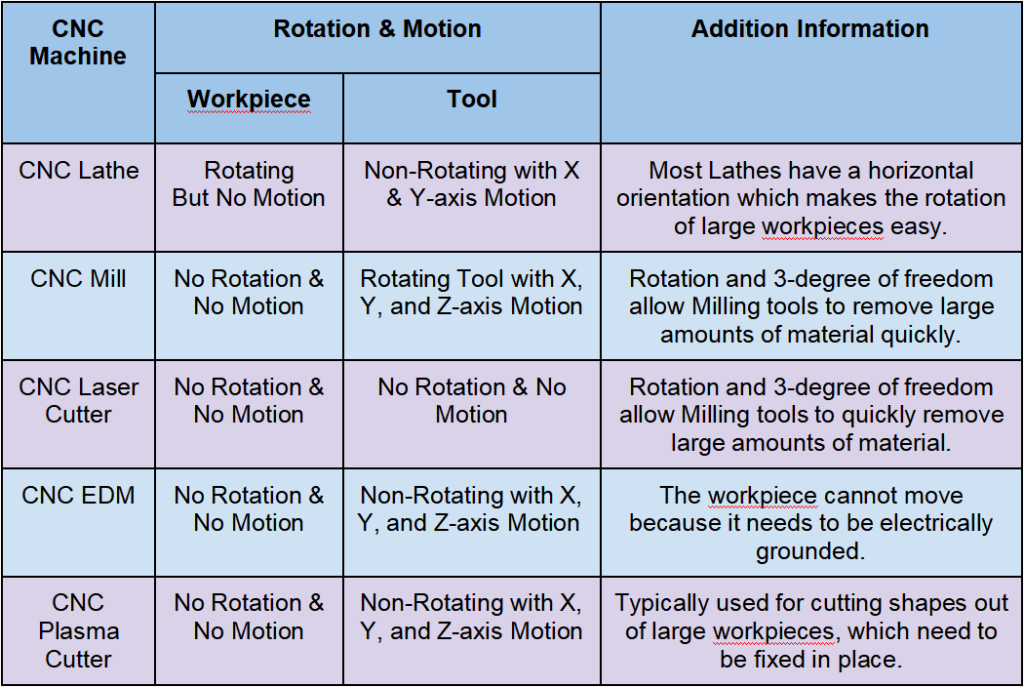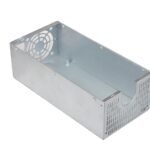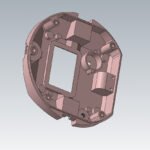In manufacturing, precision is critical, and achieving high precision by hand has never been easy. Nowadays, we have computers to help us achieve that high precision without compromising on time. Manufacturing where a computer system guides the cutting tool is called CNC Machining.
CNC machines have been an industry standard since the 1960s. But what are CNC machines? And how do they work?
This is a beginner-friendly guide designed to help you learn the basics of CNC Machining.
What is CNC Machining?
CNC machining is a subtractive manufacturing process. A computer-controlled tool removes material from the workpiece until the desired shape is achieved.
CNC stands for Computer Numerical Control, a method of automating the movement of machine tools by using computer software. A CNC machine has an embedded microcontroller, which is responsible for the motion of the machine tool. A computer then sends instructions to the microcontroller, including cutting speed, cutting depth, and the cutting path.
The computer can be a separate device, such as a laptop, which connects to the CNC machine via a cable. Or it could be an inbuilt computer attached to the outer body of the CNC machine.
Types of CNC Machines
CNC machining is just a general term for computer-controlled machining. Therefore, any cutting machine that is controlled by a computer system is a CNC machine. Following are the most common types of CNC machines.
- CNC Lathe Machines
- CNC Milling Machines
- CNC Laser Cutting Machines
- CNC Electrical Discharge Machines (EDM)
- CNC Plasma Cutting Machines
The key differences between the machines, as mentioned above, are their cutting tools. Some tools require the workpiece to be rotating for best results. While other tools give the best result with a stationary workpiece and a moving tool. Depending upon the machine type, a tool can be rotating about a fixed axis or moving in the cartesian coordinates (X, Y, and Z-axes)
Here is a simple chart to help you remember the workpiece and tool rotation/motion.

CNC machines can have either a horizontal or vertical orientation, and the direction of the tool feed determines this orientation. Suppose a tool is fed to the workpiece from the side (horizontally). In that case, the machine is horizontally oriented and vice versa.
How does a CNC machine work?
So now that you’re familiar with CNC machining and the types of CNC machines let’s discuss the technical operations of CNC machining.
CNC Machining Steps
Following are the basic steps involved in CNC machining
Step 1: Create a Design using CAD Software
CAD (Computer-Aided Design) allows you to create a 2D or 3D design according to the technical specifications.
Step 2: Convert the CAD file into CNC compatible Code
CAD files are standard across several types of software, but CNC machines operate on instructions and not design. So, you have to convert the CAD model into G-codes or M-codes.
G-codes or Geometry codes dictate the motion of the machine tool; they determine the starting point, the tool, and the stopping point.
M-codes or Machinists codes dictate the secondary operations of the machine; they control coolant rates, tool change, and other miscellaneous operations.
Step 3: Preparing the CNC Machine
Before machining, you need to perform two tasks.
- Check and test the CNC machine for errors.
- Ensure the workpiece is fixed correctly on the machine and the right tool is attached.
Step 4: Executing the Code
Finally, you can start the machining operation by entering the g/m-codes. If a computer is attached to the CNC machine, you can manually input the codes. Otherwise, you can send the code file to the CNC machine from a separate computer via a data cable.
CNC Machining Operations
Since there are several types of CNC machines, thus there are several types of CNC machining operations. The sheer number of operations can be daunting for newcomers. But don’t worry for we have a simple solution to help you with this problem.
There are two basic CNC operations that you need to familiarize yourself with, Milling and Turning. These operations are the foundation for all CNC machining. If you have a firm grasp of these, you will quickly adapt to any CNC machine and operation.
CNC Milling Process
Milling is the process of material removal from a workpiece using a rotating tool. A milling tool can move in X, Y, and Z-axes; this is particularly useful for precision work and prototyping. These three degrees of freedom are responsible for the versatility of CNC Milling Machines.
CNC Mills can be used for various functions depending on the application. But the two most commonly performed operations are, Face Milling & Peripheral Milling.
Face Milling Process
If the milling surface is perpendicular to the axis of rotation of the cutting tool, it is called Face Milling. This method of removing material is slower, as the tip of the cutter only does the milling. Therefore, Face Milling is commonly used for cutting,
Flat Surfaces
Shallow Surfaces
Flat-Bottom Cavities
Peripheral Milling Process
If the milling surface is parallel to the axis of rotation of the cutting tool, it is called Peripheral Milling. This method is primarily useful when removing large amounts of material because the entire side of the cutter is being used, rather than just the tip. Therefore, Peripheral Milling is commonly is used for,
- Cutting Deep Cavities
- & Shaping Large Workpieces
CNC Turning Process
Turning is a machining process in which the tool is fed to a rotating workpiece. If this definition reminds you of CNC Lathes, you’re exactly right. Turing is typically done on Lathe machines. However, the definition for Turing is broad enough that it is applicable for other machines.
A rotating workpiece can have quite a few advantages; the most common turning operations are,
- Boring – Cutting a long cavity into the workpiece
- Facing – Cutting the outer surface of the workpiece, flat.
- Grooving – Cutting grooves into the workpiece.
- Thread Cutting – Cutting screw threads into the workpiece.
Best Materials for CNC Machining
CNC machines are compatible with almost every material you can think of right now. As long as the material is rigid but still weaker than your cutting tool, you can easily CNC machine it. As you may have guessed, materials compatibility is more dependent on the cutting tool than the process.
While we are on the topic of cutting tools, some cutting tools are only compatible with some materials. Consider CNC EDM machines; here, the cutting tool is electric sparks. And these sparks can only exist if the workpiece is electrically conductive. So, all most non-metals are automatically ineligible for this specific machining process.
This isn’t a limitation for CNC machining. CNC EDM and Plasma cutting is rarely used. And even then, it supports most metals.
The second important criterion for material compatibility is application. CNC Milling and Turing can be performed on wood, plastics, metals, and even some composites. So the next step is to pick the material according to your desired application.
Depending upon the application, you may need to CNC machine Titanium or Aluminum. Both are very different materials with a vast difference in cost, so you must select the suitable material for your use case.
Applications for CNC Machining
CNC machine is often used to manufacture components, which are part of a bigger assembly. The material for these components depends on the application and environment of the assembled unit. Electric insulation, heat resistance, and corrosion are the two most common concerns for any component.
Following is a simple chart comparing CNC machinable materials and their applications.

This brief guide cannot mention all the possible CNC machine applications. For example, if you want custom-sized electric insulated gears, you can use nylon with a CNC mill. And if you wish to engrave metal sheets, you can use either CNC EDM or Laser cutting machines.
Approach material selection based on your unique use case. Machining takes time and experience to master, and with enough time, you will become an expert in the field.
Advantages and Disadvantages of CNC Machining
Generally speaking, CNC machining has no particular disadvantages. But CNC machines are better suited to some applications than others. Following is a brief overview of the pros and cons of CNC machining.
Advantages
The advantages of CNC machining are application dependent. If we list all the combined benefits of CNC machining, it will take over this entire guide. So, here are the most common advantages of CNC machining.
- Great for Rapid Prototyping.
- High accuracy: can only be achieved by a computer.
- High precision; can produce hundreds of parts with the exact same dimensions.
- Safer than Manual machining equipment.
- Faster Production runs, and lower lead time.
- Cost-efficient.
Disadvantages
CNC machining only has two minor drawbacks,
- Operator training is compulsory for the safe operation of a CNC machine.
- Machining Complex parts require the use of two or more CNC machines.
Conclusion
CNC machining is an incredibly versatile process; it can accommodate almost every situation. We hope that this guide has helped you get a core understanding of CNC Machines and the process of CNC Machining.
If you need CNC Machining services, QBH Technology offers CNC Milling, Turning, and Laser Cutting services. We also have excellent post-processing options, everything from welding to powder coating.
Send us your drawing files or sample photos with Material, Quantity, Tolerance, and Finishing specification, and we will get you a quote ASAP.




